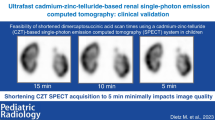Abstract
The in vivo renal volume was determined using SPECT for 99mTc-DMSA renal imaging. The total renal volume was derived by summing the DMSA distribution volumes of the transaxial slices in the whole kidney. In 20 healthy subjects the renal volume in the right kidney was 220 ml for men and 195.2 ml for women, while that in the left kidney was 213 ml for men and 193.7 ml for women. Differences in those values were not statistically significant. A good correlation was found between renal volumes in both kidneys and body surface area. In 106 kidneys including solitary and pathological kidneys, individual renal volume correlated well with individual DMSA renal uptake rate which demonstrates cortical functioning mass, depending on the cortical blood flow. Thus, SPECT enables an accurate noninvasive means of estimating in vivo functioning renal volume.
Similar content being viewed by others
References
Blaufox MD, Fromowitz A, Gruskin A, Menge CH, Elkin M (1970) Validation of use of xenon-133 to measure intrarenal distribution of blood flow. Am J Physiol 219:440–444
Breiman RS, Beck JW, Koribkin M, Glenny R, Akwari OE, Heaston DK, Moore AV, Ram PC (1982) Volume determinations using computed tomography. AJR 138:329–333
Chesler DA, Riedere SJ (1974) Ripple suppression during reconstruction in transverse tomography. Phys Med Biol 20:632–636
Haugstvedt S, Lindberg J (1980) Kidney size in normal children measured by sonography. Scand J Urol Nephrol 14:251–255
Heymsfield SB, Fulenwider T, Nordlinger B, Barlow R, Sones P, Kutner M (1979) Accurate measurement of liver, kidney and spleen volume and mass by computerized axial tomography. Ann Intern Med 90:185–187
Hosokawa S, Kawamura J, Yoshida O (1978) Basic studies on intrarenal localization of renal scanning agent, 99m-Tc-DMSA. Acta Urol Jpn 24:61–65
Ishii Y, Kawamura J, Mukai T, Takahashi M, Torizuka K (1975) Functional imaging of intrarenal blood flow using scintillation camera and computer. J Nucl Med 16:899–907
Kawamura J, Hosokawa S, Yoshida O, Ishii Y, Torizuka K (1977) Investigation of intrarenal blood flow and urine flow aspects by scintillation camera. Invest Urol 14:263–268
Kawamura J, Hosokawa S, Yoshida O, Fujita T, Ishii Y, Torizuka K (1978) Validity of 99m-Tc-DMSA renal uptake for an assessment of individual kidney function. J Urol 119:305–309
Kawamura J, Hosokawa S, Yoshida O (1979) Renal function studies using 99m-Tc-dimercaptosuccinic acid. Clin Nucl Med 4:39–46
Kawamura J, Itoh H, Yoshida O, Torizuka K (1982) Clinical evaluation of radionuclide (emission) CT using Tc-99m DMSA in urological nephropathies. In: Joekes AM, Constable AR, Brown JJG, Tauxe WN (eds) Radionuclides in nephrology. Academic Press, London, pp 77–81
Klare B, Geiselhardt B, Wesch H, Scharer K, Immich H, Willich E (1980) Radiological kidney size in childhood. Pediatr Radiol 9:153–160
Ladefoged J (1966) Measurement of the renal blood flow in man with the 133-Xe wasout technique. A description of the method. Scand J Clin Lab Invest 18:299–315
Mukai T, Ishii Y, Yonekura Y, Yamamoto K, Minato K, Morita R, Torizuka K (1978) Radionuclide emission tomography using gamma camera. In: Proceedings of the 2nd International Congress of World Federation of Nuclear Medicine and Biology, Washington, DC, pp 13
Mukai T, Minato K, Torizuka K, Fujita T, Yonekura Y, Yamamoto K, Ishii Y (1980) Characteristic of ECT by a rotating gamma camera. In: Proceedings of the 3rd Symposium on physical and technical aspects on transmission and emission computed tomography joined with 7th ICCR, Tokyo, pp 86
Murphy PH, Thompson WL, Moore ML, Burdine JA (1979) Radionuclide computed tomography of the body using routine radiopharmaceuticals. I. System characterization. J Nucl Med 20:102–107
Sorenson JA (1974) Quantitative measurement of radioactivity in vivo by whole body counting. In: Hine GJ, Sorenson JA (eds) Instrumentation in Nuclear Medicine, vol 2. Academic Press New York, pp 311
Tamaki N, Mukai T, Ishii Y, Yonekura Y, Kambara H, Kawai C, Torizuka K (1981) Clinical evaluation of thallium-201 emission myocardial tomography using a rotating gamma camera: comparison with seven-pinhole tomography. J Nucl Med 22:849–855
Tauxe WN, Todd-Pokropek A, Soussaline F, Raynaud C, Kellershohn C (1983) Estimation of kidney volume by single photon emission tomography: A preliminary report. Eur J Nucl Med 8:72–74
Willis KW, Martinez DA, Hedely-Whyte ET, Davis MA, Judy PF, Treves S (1977) Renal localization of 99m-Tc (Sn) glucoheptonate and 99m-Tc(Sn)dimercaptosuccinate in the rat by frozen section autoradiography. Radiat Res 69:475–488
Author information
Authors and Affiliations
Rights and permissions
About this article
Cite this article
Kawamura, J., Itoh, H., Yoshida, O. et al. In vivo estimation of renal volume using a rotating gamma camera for 99mTc-dimercaptosuccinic acid renal imaging. Eur J Nucl Med 9, 168–172 (1984). https://doi.org/10.1007/BF00251465
Received:
Accepted:
Issue Date:
DOI: https://doi.org/10.1007/BF00251465




